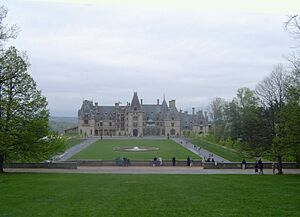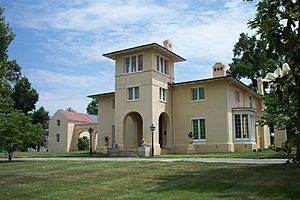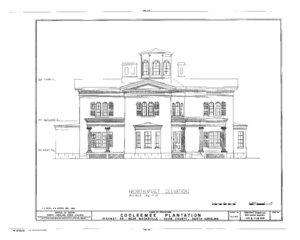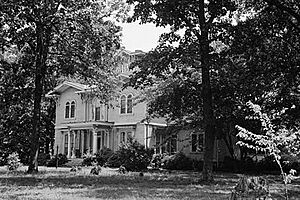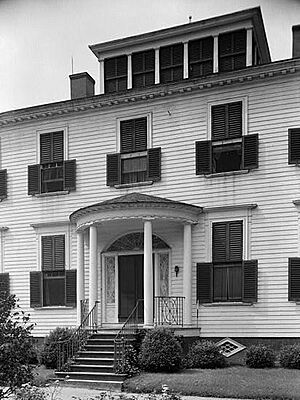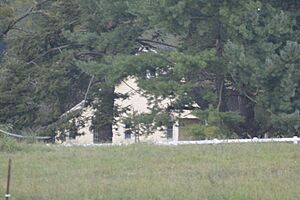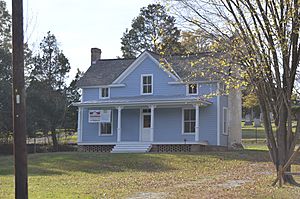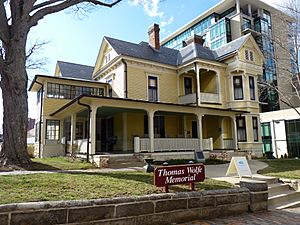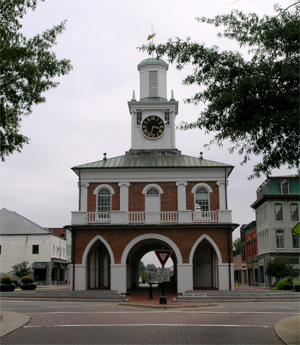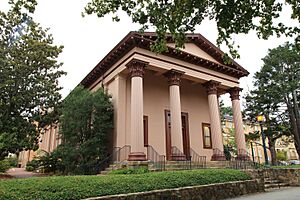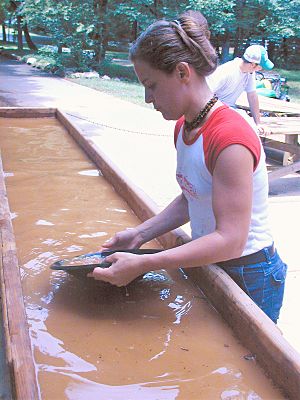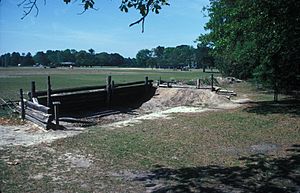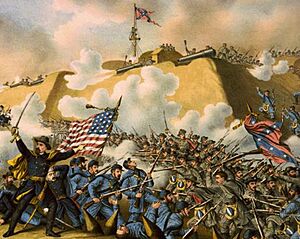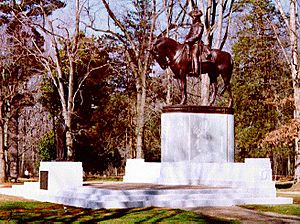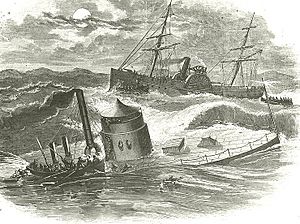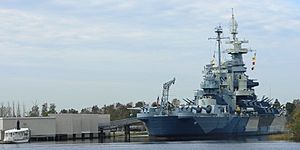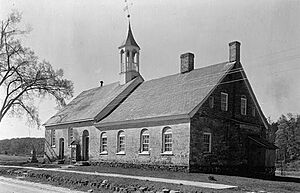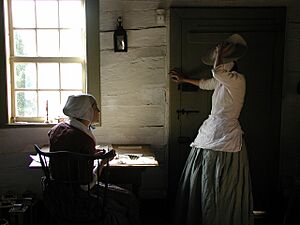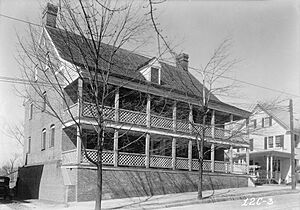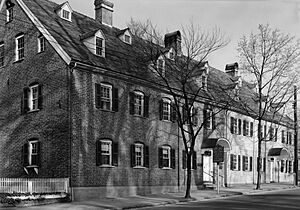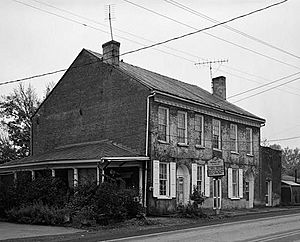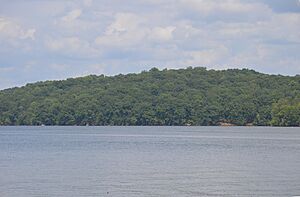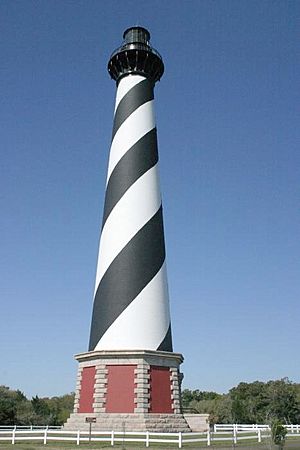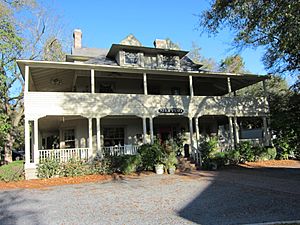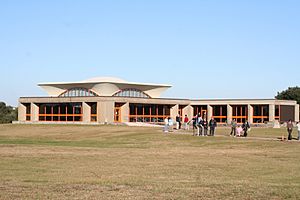List of National Historic Landmarks in North Carolina facts for kids
National Historic Landmarks are special places in the United States that have been recognized for their important history. These landmarks tell amazing stories about our country's past. They could be buildings, battlefields, or even shipwrecks!
North Carolina is home to 39 of these incredible National Historic Landmarks. Each one helps us learn more about the people and events that shaped North Carolina and the entire nation. Let's explore some of these fascinating sites!
Contents
- Historic Homes and Estates
- Biltmore Estate: America's Largest Home
- Blandwood: A Governor's Tuscan Home
- Carl Sandburg's Farm: Connemara
- Cooleemee: An Innovative Plantation House
- Coolmore Plantation: A Glimpse of the Past
- Cupola House: A Unique Edenton Home
- Hayes Plantation: A Historic Estate
- Hinton Rowan Helper House: Home of an Abolitionist
- Pauli Murray Family Home: A Center for Justice
- Nash-Hooper House: A Hillsborough Landmark
- Thomas Wolfe House: A Writer's Home
- Important Public Buildings and Sites
- Industrial and Economic Landmarks
- Military and Conflict Sites
- Religious and Community Sites
- Bethabara Historic District: Moravian Settlement
- Bethania Historic District: Another Moravian Village
- Christ Episcopal Church: Early Gothic Architecture
- Old Salem Historic District: A Living Museum
- Salem Tavern: A Historic Inn
- Single Brothers' House: Moravian Traditions
- Union Tavern: Thomas Day's Influence
- Archaeological and Natural Sites
- Recreational and Memorial Sites
- See also
Historic Homes and Estates
North Carolina has many beautiful homes that are also important historical sites. These places offer a peek into how people lived long ago.
Biltmore Estate: America's Largest Home
The Biltmore Estate in Asheville is the largest private home in the United States. It was built by George Vanderbilt in the late 1800s. This huge mansion has 250 rooms and amazing gardens. It's like stepping into a fairy tale!
Blandwood: A Governor's Tuscan Home
Blandwood in Greensboro was the home of John Motley Morehead. He was a progressive governor of North Carolina. The house was designed by a famous architect, Alexander Jackson Davis. It looks like an Italian villa right here in North Carolina!
Carl Sandburg's Farm: Connemara
Connemara in Flat Rock was the home of Carl Sandburg. He was a famous American poet and writer. This peaceful farm is now a national historic site. It lets visitors learn about his life and work.
Cooleemee: An Innovative Plantation House
Cooleemee is a historic plantation house near Mocksville. It's known for its special design, influenced by architect William H. Ranlett. This house shows how architecture was changing in the Piedmont region.
Coolmore Plantation: A Glimpse of the Past
Coolmore Plantation is located near Tarboro. This plantation offers a look into the agricultural history of North Carolina. It reminds us of the state's past farming traditions.
Cupola House: A Unique Edenton Home
The Cupola House in Edenton is a very old house. It has a special small dome, called a cupola, on its roof. This house is a great example of early American architecture.
Hayes Plantation: A Historic Estate
Hayes Plantation is another important historic site in Edenton. It's a large estate that played a role in the region's history. The plantation shows the lifestyle of prominent families in the past.
Hinton Rowan Helper House: Home of an Abolitionist
The Hinton Rowan Helper House in Mocksville was the home of Hinton Rowan Helper. He was an important writer who spoke out against slavery. His book, "The Impending Crisis of the South," was very influential.
Pauli Murray Family Home: A Center for Justice
The Pauli Murray Family Home in Durham was the childhood home of Pauli Murray. She was a pioneering civil rights activist, lawyer, and priest. Today, it's the Pauli Murray Center, dedicated to justice and human rights.
Nash-Hooper House: A Hillsborough Landmark
The Nash-Hooper House is a historic home in Hillsborough. It's recognized for its architectural style and its connection to important families in North Carolina's history.
Thomas Wolfe House: A Writer's Home
The Thomas Wolfe House in Asheville was the childhood home of famous author Thomas Wolfe. His novel, "Look Homeward, Angel," was inspired by his life in this very house. It's a must-see for literature fans!
Important Public Buildings and Sites
These landmarks include buildings and places that were central to public life and government.
North Carolina State Capitol: The Heart of Government
The North Carolina State Capitol building in Raleigh is where the state's government works. It's a beautiful and historic building. It has been the center of North Carolina's political life for many years.
Chowan County Courthouse: A Historic Courtroom
The Chowan County Courthouse in Edenton is one of the oldest courthouses in the United States. It's a great example of colonial-era public architecture. Many important legal decisions were made here.
Market House: A Unique Town Center
The Market House in Fayetteville is a very unique building. It served as a market on the ground floor and a town hall upstairs. It's a symbol of the city's history and commerce.
Old East: UNC's First Building
Old East is the very first building of the University of North Carolina at Chapel Hill. It was built in 1795. This makes it the first building of the first state university in the United States!
Playmakers Theatre: A Greek Revival Gem
The Playmakers Theatre is also located in Chapel Hill. It's an academic building designed in the Greek Revival style. This beautiful theater was also designed by Alexander Jackson Davis.
Industrial and Economic Landmarks
These sites highlight North Carolina's history in business and industry.
W. T. Blackwell and Company Tobacco Factory: Bull Durham
The W. T. Blackwell and Company Tobacco Factory in Durham is also known as the Bull Durham Tobacco Factory. It was a very important place for tobacco production. This factory played a big role in Durham's economy.
Duke Homestead and Tobacco Factory: Washington Duke's Legacy
The Duke Homestead and Tobacco Factory in Durham was the home and factory of Washington Duke. He was a key figure in the tobacco industry. This site shows the beginnings of a huge business empire.
Old North Carolina Mutual Life Insurance Company Building: Black-Owned Business
The Old North Carolina Mutual Life Insurance Company Building in Durham is a significant commercial building from 1921. It was the second headquarters of a major insurance company owned by African Americans. This building represents an important part of Black business history.
Reed Gold Mine: America's First Gold Discovery
The Reed Gold Mine near Concord is where gold was first discovered in the United States! This exciting discovery happened in 1799. Today, you can visit and even try panning for gold yourself.
Military and Conflict Sites
These landmarks mark important battles and military history.
Bentonville Battlefield: A Civil War Site
The Bentonville Battlefield near Bentonville and Newton Grove was the site of the Battle of Bentonville. This was a major battle during the American Civil War. It was one of the last big battles of the war.
Fort Fisher: A Coastal Stronghold
Fort Fisher near Wilmington was a very important coastal fort during the Civil War. It protected the port of Wilmington. The fort saw heavy fighting and was a key target for Union forces.
Guilford Courthouse National Military Park: Revolutionary War Battle
Guilford Courthouse National Military Park in Greensboro preserves part of the Battle of Guilford Court House. This was a significant battle during the American Revolutionary War. It weakened the British army, helping the Americans win independence.
USS Monitor: An Ironclad Shipwreck
The shipwreck of the USS Monitor lies off the coast of Cape Hatteras. This was a famous ironclad warship from the Civil War. It was known for its battle with the CSS Virginia. The Monitor sank in a storm in 1862.
USS North Carolina: A Mighty Battleship
The USS North Carolina is a powerful battleship docked in Wilmington. It served bravely during World War II. Today, it's a memorial where visitors can explore the ship and learn about naval history.
Religious and Community Sites
These landmarks show the history of different communities and their faith.
Bethabara Historic District: Moravian Settlement
The Bethabara Historic District in Winston-Salem is the area of a 1753 Moravian settlement. The Moravians were a religious group who came to North Carolina seeking religious freedom. This district shows their early community life.
Bethania Historic District: Another Moravian Village
The Bethania Historic District in Bethania is another Moravian settlement. It was founded in 1759. This district is a well-preserved example of a Moravian village.
Christ Episcopal Church: Early Gothic Architecture
Christ Episcopal Church in Raleigh is a beautiful church. It might be the earliest Gothic architecture church in the Southern United States. It was designed in 1846 by Richard Upjohn.
Old Salem Historic District: A Living Museum
The Old Salem Historic District in Winston-Salem is an early Moravian settlement. Today, it's a living history museum. You can see how people lived and worked in the 18th and 19th centuries.
Salem Tavern: A Historic Inn
The Salem Tavern in Winston-Salem was built in the 1700s. It was an important social center for the North Carolina Piedmont region. Many travelers and locals gathered here.
Single Brothers' House: Moravian Traditions
The Single Brothers' House in Winston-Salem is another example of Moravian architecture. It shows the unique building traditions of the Moravians. It was where single men of the community lived and worked.
Union Tavern: Thomas Day's Influence
The Union Tavern in Milton is an early 19th-century building. It has strong ties to Thomas Day. He was an influential free Black cabinetmaker. His work is highly valued.
Archaeological and Natural Sites
These landmarks reveal ancient history and important natural features.
Hardaway Site: An Ancient Archaeological Site
The Hardaway Site near Badin is an important archaeological site. It contains evidence of very early human settlements in North Carolina. Archaeologists have found many ancient tools here.
Town Creek Indian Mound: A Native American Site
The Town Creek Indian Mound near Mount Gilead is an ancient archaeological site. It was once a ceremonial center for Native American communities. You can see reconstructed buildings and learn about their culture.
Cape Hatteras Light Station: Tallest Lighthouse
The Cape Hatteras Light Station in Buxton is the tallest lighthouse in the United States! It stands 208 feet tall. This lighthouse has guided ships safely along the Outer Banks for many years.
Recreational and Memorial Sites
These landmarks are important for recreation and remembering key events.
Pinehurst Historic District: A Famous Resort Community
The Pinehurst Historic District in Pinehurst is a famous resort community. It was designed by Frederick Law Olmsted. He also designed Central Park in New York City! It includes the famous Pinehurst Resort golf courses.
Wright Brothers National Memorial: First Flight Site
The Wright Brothers National Memorial in Kill Devil Hills marks the site of the first successful airplane flight. Orville and Wilbur Wright made history here in 1903. This memorial celebrates their amazing achievement.
See also


